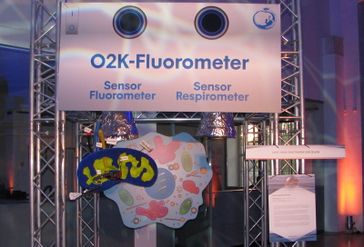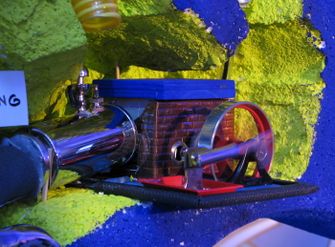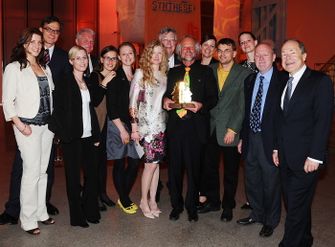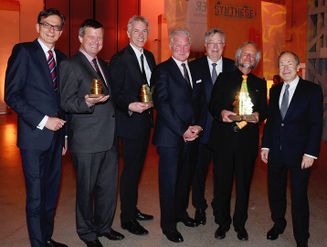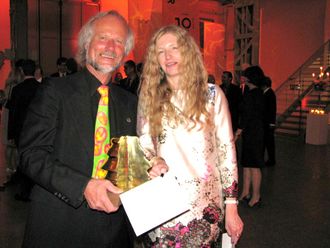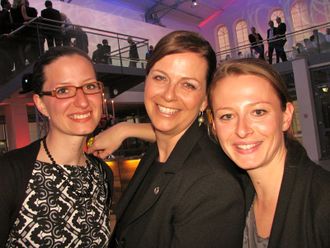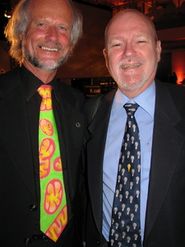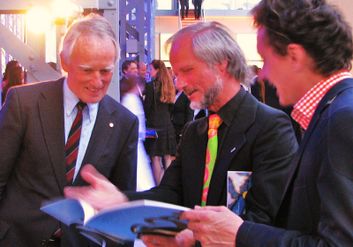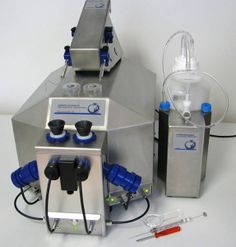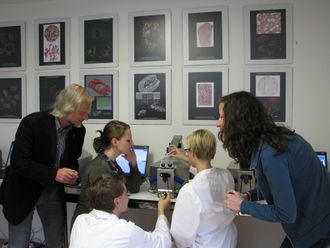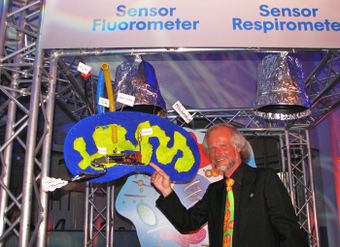- First Prize - HOUSKA Award 2012
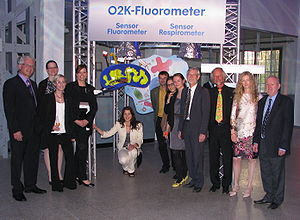
- Light in the Powerhouse of the Cells
- Erich Gnaiger (Medical University of Innsbruck, D. Swarovski Research Laboratory) and his O2k-Team (Oroboros Instruments, Innsbruck) in collaboration with Philipp Gradl (WGT-Elektronik, Kolsass) received on April 2012 the HOUSKA Award 2012
- the largest endowed research award in Austria (120 000 €).
- The winning project: Licht in die Kraftwerke der Zellen
- Medical University of Innsbruck Aktuell
- HOUSKA-award winner 2012
- HOUSKA news articles (Der Standard): 2012-04-27; 2012-05-16; (econova): Mai 2012 ; (Freizeit Kurier): 2012-06-02
- The O2k-Team together with Philipp Gradl (WGT) celebrated a successful cooperation (Vienna; 2012 April 26).
- K-Regio project MitoCom Tyrol: The O2k-Fluorometer and Mitochondrial Physiology.
- HOUSKA - a highly valued award - is a financial and innovation multiplier.
- B&C Privatstiftung HOUSKA Award Ceremony 2012-04-26
Left to right: Mag. Andrea Gnaiger, Dr. Michael Junghans (Geschäftsführer B&C Industrieholding), A.Univ.-Prof.Dr. Erich Gnaiger, Michaela Schupfer (artist and creator of the award trophy, showing Hedy Lamarr in profile, famous actress and brilliant co-inventor of 'frequency hopping' - en.wikipedia.org/wiki/Hedy_Lamarr).
Left: Katharina Stelzl, Mona Fontana-Ayoub and Katrin Stecher enjoy the award ceremony. Middle: Ties - Erich Gnaiger with MiPArt by Odra Noel (the mitochondria), David Harrison (light to the powerhouses of our cells). Right: Prof. Dr. Bernhard Auer and Prof. Dr. Michael Obersteiner take a look at Serial Art and sculptures of Richard Agreiter.
Left: The O2-Lab in the MiPArt Gallery (l to r): Erich Gnaiger, Katrin Stecher, Mario Fasching, Andrea Eigentler, Katharina Stelzl. Middle: The new O2k-Fluorescence Module. Right: Making our technology understandable at the HOUSKA Award exhibition, installation by Thomas Kuhn (Agentur „Produktionswerkstatt“).
Light in the Powerhouse of the Cells
- Submission for the HOUSKA Award 2012 (Dec 2011)
- Erich Gnaiger
- Medical University of Innsbruck, D. Swarovski Research Laboratory
Background: High-Resolution Respirometry
- The first prototype instrument for high-resolution respirometry (HRR) was developed by the group of Erich Gnaiger during the period 1989-92 through the financial support of Fonds zur Förderung der wissenschaftlichen Forschung, Austria, (FWF Project P7162-BIO; University of Innsbruck). Through the auspices of the FWF, contact was established with an industrial partner (Paar, Graz) and the first series of the Oroboros Oxygraph was completed (initially "Cyclobios Oxygraph” in 1992). In 1994, OROBOROS® was founded by Erich Gnaiger, taking over the world-wide distribution of the Oxygraph. At that time, Prof. R. Margreiter initiated with the assistance of Erich Gnaiger the D. Swarovski Research Laboratory at the Department of Transplant Surgery. The Oxygraph provided the fundamental instrument for a first extensive series of applications in hypoxia (Gnaiger et al 1995; 1998a,b; 2000; 2001; 2002; 2003; Steinlechner-Maran et al 1996) and cold storage ischemia-reperfusion injury (Kuznetsov et al 2002; 2004; Stadlmann et al 2002; Steinlechner-Maran et al 1997). These studies established a first level of bioenergetic protocols for biomedical applications of high-resolution respirometry. The scientific publications and numerous invited lectures at international conferences were instrumental in introducing the new method to the scientific community (Appendix I).
- Until 1998, only 60 Oxygraphs were produced and distributed to 17 countries. In 2000, Oroboros Instruments Corporation (GmbH) was founded, and in 2001 Philipp Gradl (WGT Elektronik; Kolsass) became the competent partner for development and production of the next generation Oroboros Oxygraph-2k (O2k). Annual sales increased to 60 per year in 2010 and 2011, up to date 360 instruments of the new O2k-generation were sold to 35 countries, and more than 500 peer-reviewed publications are listed on our website as O2k-Publications. The innovative collaboration between the Medical University of Innsbruck (D. Swarovski Research Laboratory), Oroboros Instruments and WGT-Elektronik was recognized by granting the Cluster Life Sciences Award 2010 for the O2k, at which occasion the grant application was initiated for the K-Regio project MitoCom Tyrol.
- The present development of the next generation of a new O2k-Fluorometer (K-Regio MitoCom Tyrol) is conceived as a project in two-phases. After a highly successful start of the initial phase (Appendix II), we are now producing a first series of 100 O2k-Fluorescence Modules (available for dispatch in April 2012), which can be applied as an extension of the present O2k-Core HRR System (Figure 1). In the second phase, the experience gained with the modular approach will lead to a re-design of the O2k as a high-resolution respirometer with fully integrated optical components: the new O2k-Fluorometer. Research at the Medical University in Innsbruck contributes to and will greatly benefit from these innovative methodological developments, and will further establish the world-wide reputation of the Oroboros O2k-Systems as the leading technology in the field of mitochondrial respiratory physiology and pathology.
Concept
- 2.1.Comprehensive measurement of mitochondrial function
- Oxygen supply to the cells and functionally competent mitochondria are vital. Without them, we cannot survive even for five minutes. Our daily calorie intake fuels mitochondrial energy conversion in a process consuming oxygen and known as cell respiration. Energy conversion in mitochondrial oxidative phosphorylation depends on a proton-driven membrane potential and plays a key role in maintaining a balance of redox systems and reactive oxygen species (ROS). ROS production is an essential component of many cell signalling pathways, but also induces oxidative stress in combination with diminished antioxidant capacity, as a potential cause of genetic and functional damage leading to ageing-related degenerative diseases, ischemia-reperfusion injury, and cancer.
- Figure 2: Development of the O2k-Fluorometer by the two companies, and development of diagnostic protocols for methodological evaluation of the instrument with muscle fibres, blood cells, and isolated mitochondria, illustrating the contributions of all partner institutions. Mitochondrial respiration and ROS production in muscle fibres and platelets.
- Evaluation of mitochondrial function plays an increasingly important role in diagnosis of a wide range of diseases, studies of genotype-phenotype relationships, life style diagnostics, and in sport. High-resolution respirometry (HRR; Gnaiger 2008; Pesta and Gnaiger 2012) has been a highly successful tool in all these areas of mitochondrial functional diagnosis. In order to achieve this success, research at the D. Swarovski Research Laboratory (Medical University Innsbruck), supported by the collaboration of Oroboros and WGT over the last 10 years in the development of the Oxygraph-2k (O2k) has led to its establishment as a sole-source instrument for HRR. This initiated a large growth in the world-wide market, not least due to the high quality of their product, key publications resulting from close collaborations with the Medical University of Innsbruck (DSL), and a strong international network. Continuous developments of MultiSensor upgrading of the O2k were based on the implementation of additional electrochemical sensors, as an extension of the analytical scope (nitric oxide; pH; TPP+ for mitochondrial membrane potential) for highly specialized applications (Fasching and Gnaiger 2010). Presently, however, a much larger number of publications on mitochondrial function apply spectrofluorometric methods for measurement of reactive oxygen species (ROS) and mitochondrial membrane potential using fluorescent dyes. The O2k-Fluorometer will enable the simultaneous measurement of oxidative phosphorylation, mitochondrial membrane potential, and redox or ROS balance (Figure 2).
- 2.2.Mitochondrial respiration and ROS production in muscle fibres and platelets
- The newly developed device will be tested and specific protocols will be developed for application with permeabilized muscle fibres (from small needle biopsies; Pesta and Gnaiger 2012) and platelets (from blood samples; Sjovall et al 2010). As an extension of the K-Regio project, a study will be initiated on the adaptations to up- and downhill hiking (i.e. eccentric vs. concentric contractions). Every year, thousands of tourists go hiking in the Tyrolian Alps and it is part of daily life for locals. Recent studies provide some evidence that hiking uphill induces different adaptive responses compared to hiking downhill (Drexel et al. 2008, Zoll et al. 2006, Paschalis et al. 2011). It is speculated that reactive oxygen species (ROS) signalling might be involved in these different adaptations (Ji et al. 2010).
- 2.3.Respiration, mitochondrial membrane potential, and ROS in isolated mitochondria
- Diagnostic protocols will be developed for the study of isolated mitochondria, which represent a gold standard for the separation of mitochondria-specific events (ROS production and residual oxygen consumption; mitochondrial membrane potential) from effects of the cell membrane, cytosol and other organelles (Hütter et al. 2004). As another extension of the K-Regio project, the role of human thrombocytes during a fungal infection (Aspergillus) will be investigated at the level of isolated mitochondria, evaluating the role of ROS with a perspective on pharmacological applications.
Objectives
- The objective is to achieve a comprehensive level of functional mitochondrial diagnosis by combining high-resolution respirometry and fluorometry into a single instrument capable of simultaneous measurement of respiratory function and ROS production, mitochondrial membrane potential and redox balance. The aim of this project is to develop the O2k-Fluorometer which combines all of the above-mentioned features. By implementing this instrument into application studies in sports science and clinical mitochondrial physiology, sufficient experience will be gained as a basis for transition from experimental test models to prototype, and for introducing this new product to the scientific community by direct applications (Fig. 2). To achieve these aims, MitoCom Tyrol combines the expertise of experienced partners in a unique corporate framework. The instrumental development, the evaluation of instrumental performance, and application in sport and medical science will establish MitoCom Tyrol as a Centre of Excellence in Mitochondrial Physiology (Figure 3).
- 3.1. Technological and scientific innovation
- Simultaneous optical measurements and respiration Integration of optical methods for measurement of redox states of mitochondrial cytochromes into oxygraph-instruments is a classical approach (Chance and Williams 1955). More recently this was realized in the Oxygraph-2k by inserting light guides into the chamber through the stopper and spectrophotometric measurement in an external instrument (Sommer et al. 2010). This configuration can be optimized by optical measurements obtained through the glass chamber, so that electrochemical sensors can be inserted simultaneously through drill-holes in the stopper, as a new dimension for optical and MultiSensor applications. The following two innovations are proposed in this project:
- A. Integration of respirometer and fluorometer into one instrumentFluorometry will be combined with respirometry in the O2k-Fluorometer, for extending the scope of applications, including measurement of ROS or mitochondrial membrane potential, using specific fluorescent dyes. While independently operated spectrophotometers and spectrofluorometers have been coupled experimentally to the O2k, no commercial solution is available for an integrated diagnostic system. The applied geometry (introduction of light guides via the stopper) limits MultiSensor applications of the O2k (Fig. 4A). Using commercial spectrofluorometers is very expensive and an overkill for most relevant applications in this field. Preliminary experiments have shown that it is possible to perform optical measurements (spectroscopic or fluorometric) by transmitting the light through the glass chamber of the O2k. This raises the possibility of integrating a fluorometer into the instrument capable at least of the “direct” quantification method, by incorporating a light source (LED) and a photodiode with aFigure 4: O2k-MultiSensor System with TPP electrodes inserted through the stoppers into the two chambers; the walls of the glass chambers can be seen through the windows (A) (Fasching and Gnaiger 2010b), and design of the O2k-Fluorometer, B: Excitation and detection sideways through the wall of the glass chamber; C: Excitation and emission through light guides inserted through the stopper.
- suitable filter. Therefore, only the components necessary for the desired applications have to be added, drastically reducing instrumental costs and space requirements necessary for a full spectrofluorometer. Presently, a LED is used simply for illuminating the chambers (window; Fig. 4A).
- B. Alignment of the optical sensors with the sample chamberThe presently available O2k-MultiSensor technology is based on additional sensors introduced through the stopper into the measuring chamber (Fig. 4A). Optical methods (fluorometry or UV/VIS spectroscopy) can be integrated in a different manner: The light can be transmitted directly through the O2k-glass chamber from the side of the chamber, without any direct contact of the new sensors with the sample (Fig. 4B). To avoid the use of expensive light guides inserted through the stopper (Fig. 4C), LEDs of appropriate wavelengths and intensity will be positioned within the copper block surrounding the glass chamber. Likewise, a photodiode serving as the light detector may be placed in a fixed position close to the LEDs in the copper block. Alternatively, a photodiode or light guide can be flexibly attached to the window of the O2k-chamber. The final technical aim is the full mechanical and electronic integration of the fluorescence system into the O2k and DatLab software.
- 3.1. Technological and scientific innovation
- 3.2. Application protocols for simultaneous HRR and fluorometric measurements
- To measure an analytical parameter by fluorometry simultaneously with HRR requires application protocols that derive both from standard protocols for HRR (Gnaiger 2008; 2009; Pesta and Gnaiger 2012; Scandurra and Gnaiger 2010) and for fluorometry. Suitable application protocols will be developed in this project. Scientifically, there is a growing interest in the simultaneous measurement of several functional parameters for evaluation of complex mitochondrial functions (Dykens and Will 2008). Mitochondrial membrane potential is a key element in the regulation of oxygen flux through the mitochondrial respiratory system and proton leak. It also controls ‘electron leakage’ leading to ROS production. With the development of the O2k-Fluorometer, it will for the first time be possible to perform these measurements simultaneously. This is particularly important (i) to exclude artefacts by evaluation of the effect of fluorescent dyes on mitochondrial respiration, and (ii) to extend diagnostic information obtained from limited amounts of tissue (human muscle biopsies), platelets isolated from blood samples, and isolated mitochondria (Aspergillus). New insights will be gained not only into the relations between ROS production, oxygen flux and membrane potential, but also into pathophysiological mechanisms of oxidative stress and specific injuries of the OXPHOS system (Figure 5). Figure 5. Diagnostic protocols address complex mitochondrial functions in an integrated systems approach, including electron transfer by the tricarboxylic acid cycle and matrix dehydrogenases (DH) with convergent electron flow into the NADH pool (PDH, pyruvate DH; MDH, malate DH; IcDH, isocitrate DH; OgDH, oxoglutarate DH; GDH, glutamate DH). Convergent electron flow at the Q-junction from membrane-bound dehydrogenases (CI; CII including SDH, succinate DH; GpDH, glycerophosphate dehydrogenase; ETF, electron transferring flavoprotein). Downstream control by coenzyme Q (Q), CIII, cytochrome c (c) and CIV, membrane potential, and by coupling to the phosphorylation system (F1, ATP synthase; ANT, adenine nucleotide translocase; Pi, inorganic phosphate). ROS (reactive oxygen species) production by GpDH, CI and CIII (modified from Gnaiger 2007).
- 3.2. Application protocols for simultaneous HRR and fluorometric measurements
- 3.3. Mitochondrial function and oxidative stress
- Mitochondrial respiratory capacity is the terminal element of oxygen consumption in the cascade of cardiopulmonary oxygen delivery. The dynamic balance between mitochondrial biogenesis and degradation determines mitochondrial density, closely linked to life style and physical exercise in particular. Respirometric assays on isolated mitochondria require large amounts of tissue, usually based on open muscle biopsies (up to 1000 mg of tissue we weight) involving full anesthesia. The combination of the use of permeabilized muscle fibres (Saks et al. 1998) and high-resolution respirometry (Boushel et al. 2007; 2011; Pesta and Gnaiger 2012) have made it possible to reduce the amount of tissue to ca. 10 mg based on a needle biopsy with local anesthesia. Respiratory diagnostic protocols address both quantitative and qualitative aspects of mitochondrial function. High-resolution respirometry with permeabilized muscle fibres (small needle biopsy samples of M. vastus lateralis;) offers a sensitive diagnostic test of integrated mitochondrial function (Fig. 5).
- 3.3. Mitochondrial function and oxidative stress
- 3.4. Fluorometry
- Many important bioanalytical parameters can be measured by fluorometric methods (Lakowicz 2006). The availability of a single instrumental device, therefore, opens the way to access an overwhelming scope of different applications (Halvey et al. 2008). The possible applications depend on the sophistication of the fluorometric equipment and even with a quite advanced and expensive spectrofluorometer, some special applications will not be possible due the specific hardware requirements. However, in its most simple form, fluorometry requires only a narrow bandwidth of light at the excitation wavelength as the source and a sensor which requires only a single low-pass filter to detect the fluorescent emission but exclude the excitation wavelength. The aim therefore is to use simple optical components such as Light Emitting Diodes (LEDs) as excitation sources and filters and photodiodes as fluorescence emission detectors, both being built into the surround of the O2k-glass chamber. Ideally, the system should be built modularly such that one component (e.g. for detection) can easily be replaced by a (more sophisticated) external device, allowing for an even broader range of applications (Table 1).The development for the planned instrument will be guided along two specifically selected lead applications: (i) Fluorometric determination of ROS: The most commonly used dye for the fluorometric measurement of ROS activity (Flint et al. 1997) is Amplex red (Mishin et al. 2010). ROS (e.g. superoxide, dismutated by SOD) generates hydrogen peroxide (H2O2). In the presence of horseradish peroxidase, Amplex red reacts with H2O2 to produce the red fluorescent compound resorufin (excitation wavelength 563 nm, emission 587 nm). The emitted fluorescence intensity is directly proportional to H2O2 concentration.(ii) Fluorometric determination of mitochondrial membrane potential: A number of fluorometric dyes are available for the measurement of mitochondrial membrane potential (Mathur et al. 2000; Nieminen et al. 2008).
- Analytical Parameter Dye Quantification MethodsROS (H2O2) Amplex Red direct Ca2+ Fura2 direct, ratiometric excitation Ca2+ Indo1 direct, ratiometric emmision Ca2+ Calcium green directMito. Membrane Potential Safranin direct Mito. Membrane Potential JC1 ratiometric emmision Mito. Membrane Potential TMRM direct, ratiometric excitation (?)Mito. Membrane Potential, H2O2 Rhodamin 123 direct NADH -- direct pH Fluorescein direct pH HPTS direct pH SNAFL-1 ratiometric excitation Mg2+ Magnesium orange direct ROS (HOO-.) MitoSOX direct redox state roGFP ratiometric excitation
- Table 1: A selection of fluorometric dyes, relevant in mitochondrial research.
- One of the most established ones is safranin (Kauppinen and Hassinen 1984). The excitation wavelength for this dye is 495 nm and the emission wavelength is 587 nm). Given the close proximity of the emission wavelengths of Amplex red and safranin, it is not possible to use fluorometry for the simultaneous measurement of both ROS and mitochondrial membrane potential. However, this can be achieved by using the TPP+ electrode for measuring membrane potential combined with fluorometric ROS detection.
- 3.4. Fluorometry
- 3.5. High-Resolution Respirometry coupled to fluorometry and other optical methods
- Previous studies demonstrate the feasibility of performing spectrophotometric measurements in the O2k, through the use of a specially designed stopper, light guides and an external light source (Sommer et al. 2010). With a very similar approach the O2k was coupled to a fluorescence spectrometer (Anderson et al 2011).
- 3.5. High-Resolution Respirometry coupled to fluorometry and other optical methods
Work plan and partner descriptions
- The overall strategy of the project is represented in Figure 2. The new O2k-Fluorometer is developed by WGT and Oroboros. To allow early testing, optical components are first integrated into the existing O2k system. The resulting test instruments are subjected to technical tests and used for application protocol development in They will then be tested in biomedical applications in collaboration with HMM and ISW, This will be done by strongly interconnected studies based on the simultaneous detection of H2O2 and oxygen flux with the newly developed O2k-Fluorometer.
Funding
- The MitoCom Tyrol project is in receipt of funding of € 566,592 for a 3 year period by the Förderung von Wissenschaft, Forschung und Entwicklung (Programm K-Regio); EU-Regionalförderungsprogramm "Stärkung der regionalen Wettbewerbsfähigkeit Tirols 2007-2013" together with Regional and EU support following a successful development grant application. The total budget is 1.05 Mill €, which thus is co-financed significantly by the two participating SMEs. A COST Application “MitoEAGLE” is scheduled for submission in March 2012. The proposed project is a Europe-wide extension of the MitoCom Tyrol Project aimed at evaluating mitochondrial stress in health and disease through a network for the diagnosis of acute and latent mitochondrial dysfunction. By coordinating a critical mass of expertise, the network will address the problems that may have prevented so far the major break-through required for relating the quality of life and the severity of disease to a clinically standardized measure of mitochondrial function: the MitoEAGLE Score.
Progress to date
- The first series of the O2k-Fluorescence Module will be completed by beginning of April 2012, and will be delivered in April 2012, for orders received by end of January 2012. The O2k-Fluorescence Module consists of optical probes for both O2k-chambers (green and blue excitation), optical filters, front fixation of the optical probes to the glass windows of the O2k-chambers, electronic control of light intensity, and data input into the Oxygraph-2k Core HRR (O2k-MultiSensor system).In order to support this launch, an International O2k-Fluorometry Workshop will be held from 15 to 16 March 2012, Innsbruck.
Esteem indicators and publications
- A list of publications, invited lectures and presentations at international conferences associated with the MitoCom Tyrol project is included in Appendix III. In addition, the Principal Investigator has recently been invited to become Editor of “Frontiers in Mitochondrial Physiology” in view of his leading contributions in the field.
Dissemination and exploitation
- Key features of the MitoCom Tyrol Project are dissemination and exploitation. To that end one of the project’s work packages is devoted to these tasks. Initiatives include:
- Project website (see Appendix II).
- Publicity materials.
- Initiating and facilitating international collaborations (tutoring).
- Organization of regional and international courses (Appendix III).
- Conferences - collaboration and participation.
- A MitoCom exploitation plan describes the possibilities of further use of the project outputs, including a summary for the future strategy, to ensure a long-term impact of the project activities.
- Attraction of new partners for spin-off dissemination opportunities on a regional and international level.
Economic and scientific impact
- At the end of the project, the posts created associated with the production and marketing of the Oxygraph-2k (5 FTE in each case at WGT and Oroboros) will be assured for years as a result of the improved competitiveness. With an anticipated doubling of the sales figures, a minimum of 2 FTE is expected in production and 3 FTE in sales and service. Sales of the O2K-Fluorometer are expected to stimulating annual turnover to 3 Mill Euro within a few years of which 98% will be from export sales, as extrapolated from the current world-wide distribution of the O2k (Mitochondrial Physiology Network: Figure 6).
- The project will strengthen linkages and create effective synergies between existing research competences at the Medical University of Innsbruck and the Leopold-Franzens-University with regard to exercise testing for diagnostic purposes in health and disease. The collaboration of the partner institutes will lead to the mitochondrial competencies in Tyrol becoming a single project. This should act as the seed of crystallisation for a mitochondrial centre of excellence in Tyrol which extends beyond the MitoCom Tyrol project (Figure 3). The strengthened scientific and economic collaborations will provide stimuli for the initiation of international projects and project partnerships.
- HOUSKA - a highly valued award - is a financial and innovation multiplier.



